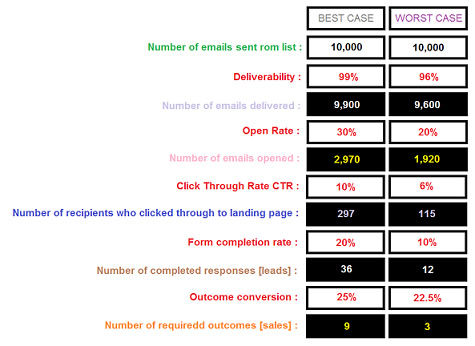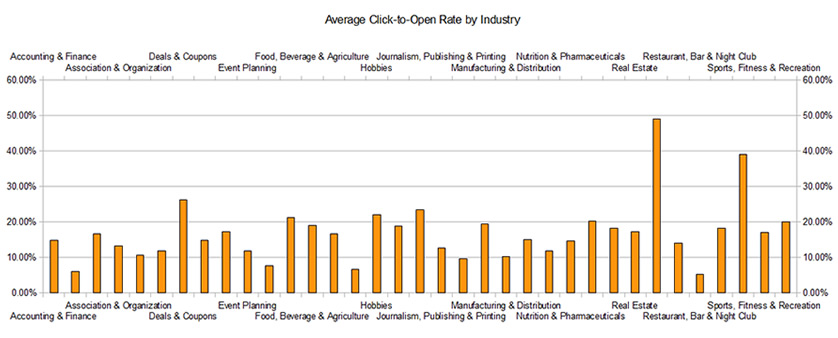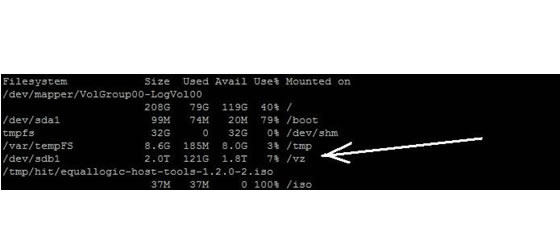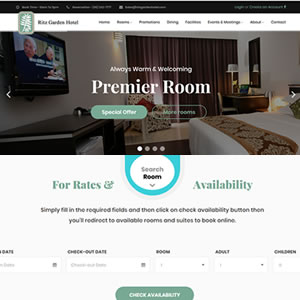How to measure effectiveness of email marketing campaign?
Email marketing is one of the most trackable marketing channels on the planet, and tools like Email88 provide you with literally hundreds of different data points about the success of your campaigns.
Key metrics are the high-level data points that show the overall success of your email marketing campaigns. These include open rate, click-through rate and unsubscribe rate among others. These are the metrics you want to be tracking across all of your campaigns to monitor the performance of your overall email marketing efforts.
Here’s an example of a model showing the best and worst case scenarios from an email marketing campaign.

#1 Emails Open Rate
Emails Open rate is a measure of how many people on your email list open your campaign. Many people I have spoken to have mixed feelings about the open rate metric. It is a very useful metric, but too often it’s seen as the end goal by marketers, because it’s a relatively easy problem to solve (just write better subject lines). The traditional calculation for CTR is the unique number of clicks divided by the number of emails delivered.
I always strongly urge clients not to compare themselves to the industry or even their vertical. It is much better to set your own benchmark and gauge your performance from that.
The issue with this metric is that it is not as accurate a measure of campaign performance because we can track who opened an email but not a great measure of how your email performed after it was opened. In other words, it cannot shows how your email performed after somebody saw it.
There are several other metrics that indicate success of a campaign better than just your open rate, especially if you’re looking to measure ROI, sales generated, or other bottom-line impacts.
That said, your open rate is important, because it has several larger implications for your marketing campaign. Opening an email is the first step in your email funnel.
If your readers aren’t taking that step, they’re as good as not in your funnel. Which means they can’t be converted into customers or have any other kind of meaningful reaction to your email marketing that impacts your bottom line.
So pay attention to your open rate, work diligently on your subject lines, but remember that there are several other metrics that should be optimized as well.

#2 – Response rate
The reply rate is exactly what it sounds like: how many people replied to your email.
The more personal you are and the more segmented your approach, the more reply rate success you'll see. Going forward is going to be the years of relationship building. This means that for each market interaction, you need to remember that the user's experience is the top priority. Provide as much delight and value to your user as possible. That’s how you triple reply rates. And that’s how you triple success.
This is a particularly important metric when running outreach campaigns, but also for your email marketing in general because it indicates list engagement. And engagement is key to a healthy list.
A list that is not engaged may still open and read emails, but they don’t act on them. If you’re seeing regular comments and replies from readers this is a good sign that not only is your list healthy and engaged, but you’re creating content that your audience wants to see.
It's no secret that reply rate is the golden metric of email campaigns.
The reason is obvious. As opposed to open and click rate, reply rate tracks how many recipients were interested (or annoyed) enough to actually write you back. For email outreach, your reply rate will determine your campaign's success.
It’s important to understand the applications and situations before you try to predict your response rate.
A low response rate is a good approximation if:
1. You are mailing to an outside mailing list (meaning any list that is not your own)
The people on outside mailing lists have no relationship with you. You are a stranger to them so you have an uphill battle when it comes to generating a response.
2. You are using a free offer than requires little commitment on the part of your audience.
Free offers are central to all lead generation campaigns. The concept is simple. You create a free report or white paper on a topic closely related to what you sell. You then offer the report to your target audience – and those people who are interested in the topic will respond. These leads are then considered potential customers.
Because these offers are free, you can expect more people to respond.
#3 – Clickthrough rate
Now that you know people are opening and reading your emails, you want to look at if they’re clicking through. Effective, high-converting emails are not written to get a reader to buy immediately, but to click on a link, making clickthrough rate the best metric for measuring how effective your emails really are.
That’s because they reflect how well you persuade your readers to click that link.
Low clickthrough rates can indicate problems in several areas — maybe the call to action wasn’t clear enough. Or your body copy wasn’t persuasive enough. Or maybe you weren’t sending your readers the right offer and they’re simply not interested. This last one is particularly likely if you haven’t segmented your list.
Segmentation is key to a high clickthrough rate (as well as engagement) as it lets you send offers and content only to those people who have indicated interest in them–which means they’re already more likely to clickthrough and convert.
CTR depends not only on the subject lines (which affect email open rates), calls to action and shiny copy. Subtler elements like link positioning, time of the day, email length, link emphasis, can make or break the CTR. These external factors play a significantly larger role than anyone would really like them to. However, there are things you can do which we will come to in a moment.
A higher email click-through rate means a good email campaign has been waged. A lower CTR doesn’t necessarily mean that the email campaign was bad, merely that adjustments are needed. Remember, the average email click-through rate depends on the industry, as well as the niche and nature of your email.
#4 – Overall conversion rate
The difference between conversion rate and clickthrough rate can get a bit murky. Technically, since the goal of your email is to get a reader to click, your clickthrough rate could easily be considered your conversion rate for that email.
"Conversion rate" is the percentage of visits to your site that result in a "conversion". For most of us, a conversion is either a sale, or a lead of some kind, typically related to the number of visits or sessions:
Conversion Rate = Number of Sales / Number of Visits
In other words, if your store is visited 100 times and 5 of those visits ends in a sale, you have a 5% conversion rate.
The reason people care about that, and the big idea behind conversion optimization, is that if you can figure out how to increase your conversion percentage, you will make more sales for the same traffic costs.
However, your overall conversion rate refers to the percentage of readers who opened your email, clicked through, and continued on to actually buy your product or sign up for your service (or any other conversion goal you set).
Tracking conversion from email open to purchase makes it easier to track the ROI of your email marketing program, because you know how many of those email readers turned into actual customers.
When you combine that with the average order size of your readers, you can directly link your email marketing program to specific revenue amounts, which is extremely valuable for your company.
In short, when looking at your emails, make sure you’re tracking metrics that help you understand how people are interacting with your emails, and that help you see how your email marketing program fits into your company’s revenue stream as a whole.





